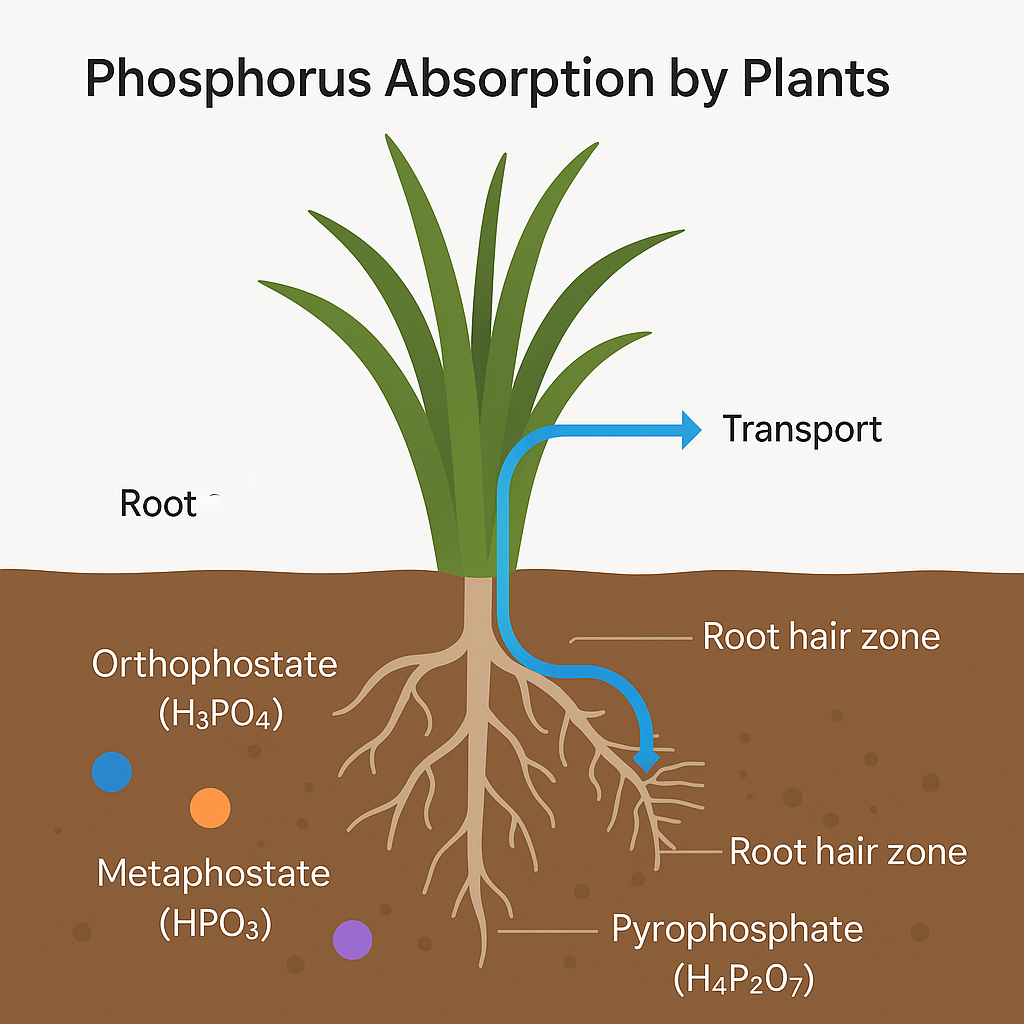Phosphorus is a vital nutrient for plant growth, playing an essential role in energy transfer, protein synthesis, and nucleic acid formation. Understanding how crops absorb and utilize phosphorus, as well as the factors influencing this process, is crucial for optimizing fertilization practices and ensuring healthy crop development.
1. How Crops Absorb and Utilize Phosphorus
Crops primarily absorb phosphorus through their roots, with the root hair zone being the main absorption site. Phosphorus is absorbed in several forms, including inorganic phosphates like orthophosphate (H₃PO₄), metaphosphate (HPO₃), and pyrophosphate (H₄P₂O₇), with orthophosphate being the most readily absorbed form. Plants can also take up organic phosphorus, such as hexose phosphate esters, sucrose phosphate esters, and glycerol phosphates.
Once absorbed, phosphate ions rapidly participate in metabolic processes. Phosphorus in the xylem is predominantly inorganic, while both inorganic and organic phosphorus are found in the phloem. Inorganic phosphorus moves easily within the plant, supporting upward or downward transport, particularly to growing organs like flowers and fruits.
2. Symptoms of Phosphorus Deficiency and Excess Supply
1. Phosphorus Deficiency Symptoms
- Slowed Growth: Stunted plants with poor root development, fewer tillers, and smaller leaves.
- Leaf Changes: Older leaves turn dark purple or red, followed by yellowing, chlorosis, and eventual leaf drop.
- Reduced Flowering and Fruit Production: Difficulty in flower bud differentiation, fewer flowers, and delayed fruit ripening.
Different crops exhibit distinct deficiency symptoms. For example:
- Tomatoes: Dark green leaves, reduced gloss, few flowers and fruits, delayed maturity.
- Rice: Slow growth, short stature.
- Wheat: Purple stem base, small and sparse spikes.
- Corn: Purple-red leaves, small ears.
- Cotton: Small plants with fewer branches.
- Canola: Slow leaf emergence, small leaf area.
- Tobacco: Narrow leaves, dark color.
- Soybeans: Small leaves, red stems.
- Potatoes: Wrinkled leaves, internal rust-like discoloration in tubers.
2. Phosphorus Over-Supply Symptoms
- Growth Inhibition: Over-application of phosphorus shortens the vegetative growth period, hastening maturation. Excessive tillering and smaller seeds also occur, with leaves becoming thick and dense, and the plant stays small.
- Root System Changes: Overdeveloped, short, and thick roots can impede the normal growth of aboveground parts like stems, leaves, and flowers.
- Quality Decline: Excessive phosphorus can lead to increased cellulose content, enhanced lignification, and reduced food quality. For fruits, reduced juice content, lower sweetness, poor coloration, and diminished overall quality may occur.
3. Key Factors Affecting Phosphorus Absorption
1. Crop Characteristics and Growth Stages
Different crops vary in their ability to absorb phosphorus. Crops like canola, soybeans, peanuts, and broad beans are phosphorus-efficient. Root structure and root hair development also play crucial roles in phosphorus uptake, especially when soil phosphorus levels are low. For instance, onion roots lack root hairs, reducing phosphorus uptake capacity, while canola adjusts its ion absorption ratio to acidify the rhizosphere, increasing phosphorus availability.
Many plants can secrete H⁺ ions or organic acids, which help increase phosphorus availability in the soil. For example, the white clover can secrete both H⁺ and organic acids to chelate iron and aluminum ions, enhancing phosphorus solubility. Additionally, plants exhibit varying phosphorus demands during different growth stages, such as the seedling, flowering, and fruit expansion stages.
2. Soil Phosphorus Availability
Plants primarily absorb inorganic phosphorus from the soil, and while organic phosphorus can be absorbed, it must first be converted into inorganic forms. Soil phosphorus availability is influenced by several factors, including the soil’s pH, temperature, moisture, texture, and clay mineral content. Phosphate ions diffuse through the soil solution, but the rate of diffusion depends on the concentration gradient, as well as these environmental factors.
Soils with higher organic matter content tend to increase phosphorus efficiency. The presence of organic matter can enhance phosphorus solubility, thus improving its availability to plants.
3. Mycorrhizal Fungi
Mycorrhizal fungi significantly enhance phosphorus uptake by extending the root system through their mycelia. These fungi also increase the affinity for phosphate ions and release organic acids that help solubilize insoluble phosphorus compounds, improving its availability. However, not all plants form symbiotic relationships with mycorrhizal fungi, so phosphorus absorption capacity varies across plant species.
4. Environmental Factors
- Temperature: Increasing soil temperature (within the range of 10-40°C) accelerates phosphorus diffusion and root growth, thus improving phosphorus uptake.
- Moisture: Adequate moisture in the soil facilitates the diffusion of phosphorus in the soil solution.
- Soil pH: The soil’s pH significantly affects phosphorus uptake. Acidic soils benefit from the application of alkaline phosphorus fertilizers like calcium-magnesium phosphate, while alkaline or neutral soils respond better to acid-form phosphorus fertilizers like superphosphate.
5. Nutrient Interactions
Phosphorus and nitrogen interact closely in plant nutrition. Nitrogen application often promotes phosphorus uptake due to the involvement of phosphorus in nitrogen metabolism, nitrate reduction, ammonia assimilation, and protein synthesis. A balanced application of nitrogen and phosphorus fertilizers can promote better overall plant growth and nutrient absorption.
Understanding phosphorus absorption mechanisms and the factors that influence its availability is essential for optimizing fertilizer practices and achieving higher crop yields and better quality produce. By considering crop types, soil conditions, and environmental factors, farmers can develop more effective fertilization strategies.
For expert advice on phosphorus fertilization, soil management, or crop nutrition solutions, feel free to contact us!
📧 sales@wellyoutech.com | 📞 +86 131 3110 5780


